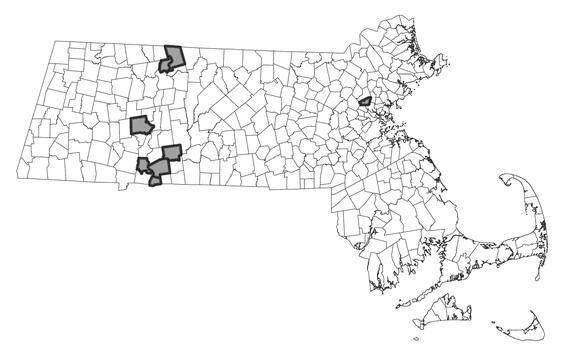- Scientific name: Ludwigia polycarpa
- Species of Greatest Conservation Need (MA State Wildlife Action Plan)
- Endangered (MA Endangered Species Act)
Description
Many-fruited seedbox is a much-branched, 2-10 dm (7 in-3 ft) tall, herbaceous perennial with small, inconspicuous, 4-sided greenish flowers occurring in the axils of the upper leaves. This member of the evening primrose family (Onagraceae) is found in swamps, sloughs, marshes, and wet prairies.
Many-fruited seedbox has erect, 4-angled stems with sessile, alternate leaves that are lanceolate or linear-lanceolate in shape and 4-10 cm (~1.5-4 in) long. Plants bloom in August and September, and the flowers are sessile or on obscure pedicels less than 1 mm long in the leaf axils of elongate, leafy spikes. Four minute, greenish petals arise from the top of each side of a 4-sided cup-like receptacle (hypanthium) surrounding the ovary. The fruit is a roundly 4-sided or shallowly grooved, short-cylindric capsule that is 4-7 mm long (0.13-0.25 in) and 3-5 mm (0.12–0.2 in) in diameter. The capsule is smooth (glabrous) and contains many seeds. Short, leaf-like appendages called bracteoles are inserted well above the base of the hypanthium. The lack of definite pedicels for the flowers differentiates L. polycarpa from the similar L. alternifolia, which has pedicels 3-5 mm (0.12–0.2 in) long. Many-fruited seedbox should not be confused with species in the loosestrife genus (Lythrum) in the family Lythraceae. True loosestrifes usually have 6-merous flowers with red-purple to white petals and 2-celled capsules.
Life cycle and behavior
This is a perennial species.
Population status
Many-fruited seedbox is listed under the Massachusetts Endangered Species Act as Endangered. All listed species are protected from killing, collecting, possessing, or sale and from activities that would destroy habitat and thus directly or indirectly cause mortality or disrupt critical behaviors. Many-fruited seedbox is considered to be rare in Vermont and Pennsylvania and is thought to be extirpated in Connecticut. The Massachusetts Natural Heritage & Endangered Species Program has 14 records from 4 counties: Franklin, Hampden, Hampshire, and Middlesex. Seven of these records have been observed within the last 25 years.
Distribution and abundance
The documented range of many-fruited seedbox extends from central Ohio and southern Ontario to southeastern Minnesota south to the Ohio River Valley of Kentucky, northeastern Arkansas, eastern Nebraska and eastern Kansas. To the northeast, this seedbox is a rare disjunct, occurring locally along the Susquehanna River in Pennsylvania, near Lake Champlain in Vermont, and along the Connecticut River in Massachusetts.

Distribution in Massachusetts. 2000-2025. Based on records in the Natural Heritage Database.
Habitat
In Massachusetts, many-fruited seedbox occurs almost exclusively in river floodplains, where it inhabits wet, exposed mud in oxbows and depressions within the zone of annual flooding. Canopy cover at the floodplain sites varies from nearly open to closed and is composed mainly of silver maple (Acer saccharinum), green ash (Fraxinus pennsylvanica), pin oak (Quercus palustris), and/or black willow (Betula nigra). Other frequent associates are northern water-plantain (Alisma subcordatum), false nettle (Boehmeria cylindrica), false water-pepper (Persicaria hydropiperoides), ditch-stonecrop (Penthorum sedoides), water purslane (Ludwigia palustris), swamp candles (Lysimachia terrestris), and buttonbush (Cephalanthus occidentalis).
Healthy habitats are vital for supporting native wildlife and plants. Explore habitats and learn about conservation and restoration in Massachusetts.
Threats
The primary threat to many-fruited seedbox is the loss of floodplain habitat.
Conservation
As with many rare species, exact needs for management of many-fruited seedbox are not known. The following comments are based primarily on observations of populations in Massachusetts. Although many-fruited seedbox inhabits a wide variety of wetland habitats in the Midwest, it is mainly limited to river floodplains in Massachusetts and its occurrence is linked to the availability of suitable floodplain habitat. Undisturbed floodplain habitat is rare throughout the state due to housing and industrial development and to conversion of these highly-fertile areas to agricultural land. The success of many-fruited seedbox in Massachusetts will depend on the protection of remaining floodplain habitat, rather than species-specific management techniques.
Contact
| Date published: | April 30, 2025 |
|---|